Single spun yarns are by nature over-twisted. They kink and try to twist back on themselves and can be difficult to work with. Weavers sometimes use singles but if you knit or crochet with it the twist will skew your article unless you use both right and left twists alternatively.

How to Ply Your Hand Spun Yarn
by Ragtimelil
Once you’ve spun your yarn, you must decide whether to leave it as is or whether to ply it. Here's some ways to make two or three-ply yarns.
Here's a sweet little pouch I knitted out of Sheltie hair. I used a single spun yarn and no amount of blocking will make it lay straight.
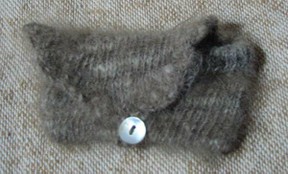
Plying is twisting two or more yarns the opposite direction from the way they were spun. This will make the yarn stronger yet cause it to "relax."
Getting Your Yarn
Spinners usually spin clockwise, called a Z twist. Spinning the other way produces a S twist. The Z and S represent the lines in the yarn. If you look at the yarn, you can see which way it twists. If you use two yarns to ply, generally you will use two spun in the same direction and ply it in the opposite direction.
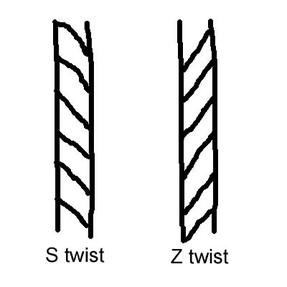
Plying from Two Balls or Bobbins
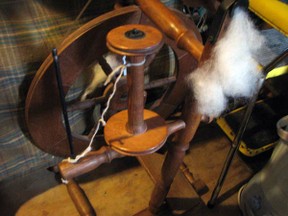
To make 2 ply yarn you need your two yarns either on separate bobbins, or wound onto two balls. The balls can be placed in two bowls to keep them from rolling across the floor. The bobbins are generally placed on a lazy kate. My spinning wheel has a lazy kate built into it. They are easy enough to make if you don't have one.
I've made them out of two knitting needles and a cardboard box. I poked the needle through one side of the box, threaded on my bobbin, and then poked it out the other side of the box.
Plying
Take the two ends of the yarn and tie it to your leader. Then simply spin the opposite way from the way the singles were spun. Some people keep one yarn in each hand and allow them to twist together. I like to keep both in one hand and keep a finger between them.
When I am done plying I wash the yarn and hang it with a weight to set the twist. I generally use the damp towel I squeezed it with to get the water out.
Center Pull Balls
You can also ply from a center pull ball. My Royal ball winder makes really nice center-pull balls of yarn. The critical thing is to keep your thumb in the hole in the center. Otherwise you will end up with a snarl that will be unbelievable.
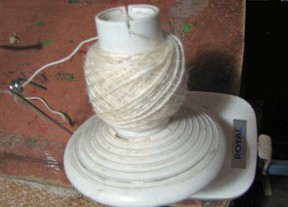
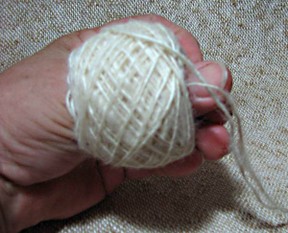
You can make a center pull ball by winding on a nostepinne or just by hand. I'm not very good at this so I won't try to explain it.
Andean Ply
If you have a small amount of yarn to ply, you can use the Andean ply method. It’s more of a method of holding the yarn rather than an actual method of plying. It is used most often on a drop spindle, but it can be used on a wheel as well.
The yard is wrapped around your hand and middle finger. When done, slip the middle finger out so that the yarn is around your wrist. Take both ends and ply.

In the following video, they’re wrapping on a plying tool.. When they’re done wrapping, the just pull the dowel out and ply from the two ends.
Andean Plying Tool
Navajo 3-Ply
To make a nice 3-ply yarn that is even stronger and makes a good sock yarn, I use the Navajo ply. It’s rather like crocheting by hand and works from a single strand of yarn.
Holding the yarn in your less dominant hand, make a loop with the yarn. Put your other hand through the loop and grasp the yarn and, as you spin, pull enough through to put your hand through again. Repeat this process until you’re done.
In this video, she’s just using her fingers to pull the yarn through. That works too.
Navajo Plying
Final Product
Plying goes much faster than the spinning. I enjoy plying and seeing the finished product. There are all sorts of ways to do fancy art yarns too by mixing yarns and using special techniques.
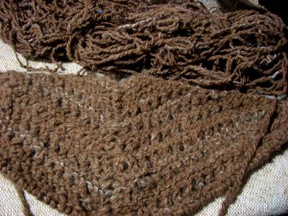
Pictured is a shawl started out of 2-ply llama hair.
You might also like
How to Buy a Spinning WheelHave you thought of getting a spinning wheel and relaxing to the feel of wool...
How to Spin Yarn Without a Spinning WheelAlways thought you'd like to learn how to spin, but didn't want to spend the ...
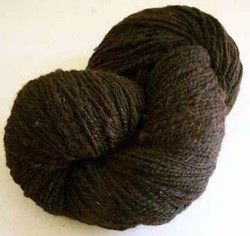

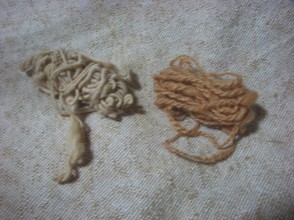







 How I Found My Free Family History Programon 09/05/2013
How I Found My Free Family History Programon 09/05/2013
 Finding a Graveon 09/01/2013
Finding a Graveon 09/01/2013
 Do Border Collies Make Good Pets?on 08/11/2013
Do Border Collies Make Good Pets?on 08/11/2013
 Hubert Patey - an Indentured Servanton 08/02/2013
Hubert Patey - an Indentured Servanton 08/02/2013
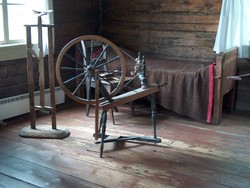
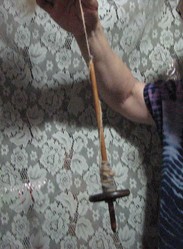
Comments, Questions and Other Words of Wisdom
Oh I'm so glad. You'll have to tell me all about it. What are you spinning on and what fibers...
I am just starting to spin and so I loved this article! Great work! I will have to check out your pieces on spinning!
Thank you. Yes, there are some skills that will disappear if we don't keep them alive. I love learning about how things were made "back in the day."
This is amazing, thank you for sharing your knowledge with the world. I have a feeling this may otherwise have been a lost art. My youngest daughter knits, I will share this with her. :)K
I've been told, just write about what you know. I do love to spin, but it's starting to strain my eyes.